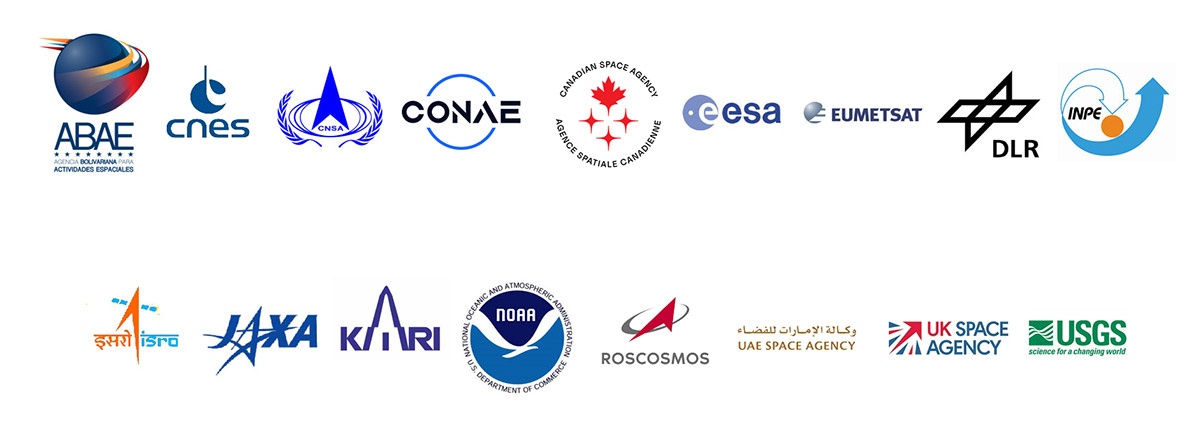A Global Response to Disasters: The Birth of the International Charter Space and Major Disasters
In , the UNISPACE III conference recommended the establishment of an integrated, global system to manage disaster mitigation, relief, and prevention efforts through international cooperation.
In response to this call for action, the European Space Agency (ESA) and France's Centre national d'études spatiales (CNES) proposed a groundbreaking initiative: the International Charter Space and Major Disasters. The Canadian Space Agency (CSA) joined this international effort by signing the Charter in .
Since its inception in , the Charter has played a crucial role in coordinating global satellite resources to support emergency responses. It provides free, rapid access to satellite imagery to support rescue and emergency responders around the world and has repeatedly shown the power of international collaboration in addressing natural and man-made disasters.
As of , 943 disasters have been imaged by contributing satellites in 136 countries worldwide.
The Charter's evolution over time
Charter membership and contributing satellites
Member space agencies and space system operators cooperate on a voluntary basis, with no exchange of funds, with each organization devoting resources to support the Charter. Including ESA, CNES, and the CSA, there are currently 17 members.
List ordered by the year in which each member officially joined the Charter
- ESA ()
- CNES ()
- CSA ()
- U.S. National Oceanic and Atmospheric Administration (NOAA) ()
- Indian Space Research Organisation (ISRO) ()
- Comisión Nacional de Actividades Espaciales (CONAE) (Spanish only) ()
- Japan Aerospace Exploration Agency (JAXA) ()
- United States Geological Survey (USGS) ()
- United Kingdom Space Agency (UKSA) ()
- China National Space Administration (CNSA) ()
- German Aerospace Center (DLR) ()
- Korea Aerospace Research Institute (KARI) ()
- Brazilian Instituto Nacional de Pesquisas Espaciais (INSPE) (Portuguese only) ()
- European Organisation for the Exploitation of Meteorological Satellites (EUMETSAT) ()
- Russian Federal Space Agency (ROSCOSMOS) ()
- Agencia Bolivariana Para Actividades Espaciales (ABAE) (Spanish only) ()
- United Arab Emirates Space Agency (UAESA) ()

The increase in Charter membership and the growing number of Charter satellites has led to faster and more comprehensive imaging capabilities. The Charter now has 270 contributing satellites, including nine SAR satellites, which allow for thorough, 24 hours a day, 7 days a week, global coverage.
- In , 26,764 optical and radar images were provided by the Charter to support 63 disaster responses. For 90% of the Charter activations, the first crisis post-event image was delivered within two hours.
Third-party data contributors (i.e., Earth observation [EO] satellite owners or operators that are not Charter members) have also expanded the satellite data and enriched its quality.
List of current contributors
Improved access to satellite data for Charter users
Launched in , the Universal Access principle has allowed organizations to become Authorized Users (AUs) who may trigger Charter activations without being fully fledged Charter members.
- Since the principle came into effect, the number of AUs has almost doubled: there are now 98 AUs from 87 countries.
Organizations entitled by the Charter Board to promote and trigger the Charter on behalf of their clients (known as Cooperating Bodies [CBs]) have increased the frequency of Charter activations. These CBs have also provided guidance and training to civil defence organizations on the benefits of the Charter and the process for becoming Charter AUs or members.
- Two United Nations (UN) organizations, namely the UN Office for Outer Space Affairs (UNOOSA) and the UN Institute for Training and Research (UNITAR/UNOSAT), as well as the Sentinel Asia initiative for the Asia-Pacific region, have official agreements with the International Charter for activating the Charter on behalf of their users.
Coordination Agreements for enhanced emergency response
The Charter has signed coordination agreements with the Copernicus Emergency Management Service, the Committee on Earth Observation Satellites Working Group on Disasters and United Nations' Global Disaster Alert and Coordination System to increase the visibility of EO data available to disaster responders and risk managers.
Advancing Charter Operations: The Role of COS-2 and Charter Mapper Software
The COS-2 software, developed by ESA, manages the workflow of Charter activations. It has improved the efficiency and timeliness of satellite data management, utilizing a Web interface to facilitate the work of the different Charter operational staff members. Project Managers (PMs), Emergency on-Call Officers (ECOs), and AUs have individualized dashboards for completing tasks related to Charter activations.
The Charter Mapper, an EO-based processing environment to support activations that was implemented by ESA, has further enhanced the efficiency of operations by allowing PMs and value adders to visualize imagery in full resolution and execute processing services. This then allows for the quick retrieval of geoinformation to provide end users with quality value-added products in a timely manner. The Charter Mapper is intended to ease access and use of the data collection from a Charter activation, as datasets of interest can be downloaded directly from the platform for processing using other software. The Charter Mapper has a suite of processing services capable of retrieving geoinformation from multi-sensor satellite imagery that can be used in value-added products such as burned area maps, flood maps, etc.
Looking towards the future
Looking ahead, the Charter remains committed to driving innovation and embracing new opportunities. This includes fostering greater collaboration among EO disaster services and expanding its network of satellites and data sources. It also focuses on enhancing image processing capabilities and welcoming new AUs and members. Most regions of the world are well covered with Charter AUs; however, dedicated efforts and training may be required in areas lacking coverage, in order to raise awareness and build capacity for this humanitarian initiative.
As the number of Charter activations grows each year, with the last two years both being the most activations ever in a single year, international collaboration and contributions from data contributors and partners will become ever more important. The ultimate goal is to deliver faster and more accurate information to disaster responders worldwide.
